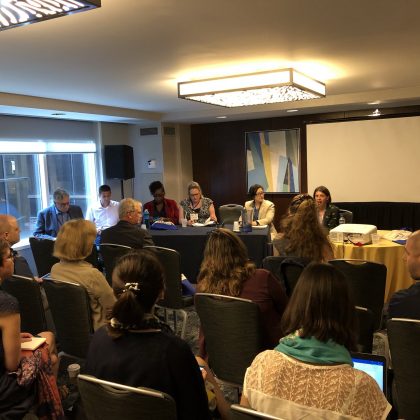Tips on Publishing in a Peer-Reviewed Journal
Christopher W. Schmidt, the Editor of Law & Social Inquiry, offers advice on publishing in a peer-reviewed journal.
Your Abstract Is More Important Than You Think
Law & Social Inquiry (LSI) regularly receives strong manuscripts with weak abstracts. First impressions are important, and the first impression you’ll make with our editorial team and potential reviewers comes from your title and abstract.
Poor abstracts cause particular challenges. We distribute titles and abstracts to our editorial board and to the community of the American Bar Foundation (LSI’s home institution) to solicit recommendations for peer reviewers. And when we invite a scholar to review a manuscript, we send them the abstract. A weak abstract makes it much harder for us to line up the best possible reviewers for a manuscript.
What makes a good abstract? The simplest advice is to avoid making it too broad or too narrow. A broad abstract risks coming across as arrogant or naïve. A narrow abstract risks coming across as of limited interest beyond a small group of specialists. A good abstract explains why your topic is important and persuades the reader that you have something interesting and significant to say about that topic.
The title, abstract, and introduction should each basically do the same thing: describe the topic of the article and what you have to say about it.
It’s less important that an abstract be complete than it be compelling. Weak abstracts often conscientiously describe every element of the article, but in so doing they become lifeless to-do lists. Strong abstracts capture the article rather than summarize it. The goal is to provide a coherent story about the article, one that engages the reader and persuades her that the article is worth reading.
Remember Your Audience I
Who is this “reader” you’re trying to engage and persuade? In the realm of peer-reviewed journals, it’s best to think of two kinds of readers: the expert and the generalist. You need to write for both.
The expert view will be reflected in your peer review reports. These are readers selected because of their expertise on the topic of your manuscript, and to gain their approval you need to demonstrate your knowledge, be precise in your facts, and be complete in your references to the relevant scholarship. If you’re doing quantitative analysis, your methods must be sound.
The generalist view is sometimes reflected in the reader reports, but more often the journal editors are the ones who assume this role in the review process. When making editorial decisions for LSI, I often position myself as a “general” reader of the journal—a reader, that is, who is not an expert in the field of a given manuscript, who may have no particular interest in the topic, but who nonetheless might find something interesting and valuable in this particular piece of scholarship. This is hardly a stretch for me, since for the vast majority of articles LSI considers, this is pretty much is who I am: non-expert but curious and open to new insights.
Don’t forget about your potential generalist audience. One of my goals at LSI is to publish articles that will be read beyond a small circle of specialists.
Remember Your Audience II
The target audience for an interdisciplinary journal is different from that of a disciplinary journal. When, for example, LSI receives a legal history submission, I line up as reviewers not just historians but also scholars in other disciplines who draw on legal historical scholarship. What appeals to this kind of reader is likely different from what appeals to the legal historian. If the entire motivation for your article is to contribute to some debate among legal historians, you risk losing much of your potential audience. You need to show why non-legal historians should care about this particular legal historical debate.
The primary goal of an interdisciplinary journal is not to offer a sampling of disciplinary work; it’s to publish articles that allow and encourage people to read across disciplines. If you are interested in publishing in LSI, you should keep this in mind.
Take the Author Revision Memo Seriously
In addition to the manuscript itself, the most important document that the author submits is the letter that accompanies the manuscript when it has been revised after a “revise-and-resubmit” initial decision. (Note: Cover letters that accompany the article on initial submission, while sometimes necessary to explain some issue or unusual circumstance, play little to no role in our evaluation process.) The revision memo need not be particularly lengthy or minutely detailed, but it should be generous, thoughtful, and carefully written. It’s an opportunity to emphasize the seriousness with which you approach the revision process.
The revision memo also allows you to explain to the editors and the peer reviewers why you chose not to make a suggested revision. I would rather see an author defend an authorial choice—and hopefully persuade a skeptical reviewer of the validity of that choice—than just accept all criticisms and suggested revisions. Embrace those suggestions that make your article better. But when you receive a suggestion that you believe doesn’t work for your article, respectfully say so and explain why. Use the revision memo to your advantage. It not only can improve your chances of having your article accepted, it can also allow you to publish a better article.
The Process Works. Usually.
Having watched the peer-review process from the inside, I can say that as a general matter it works. Truly excellent scholarship is identified as such and sails through the process. Strong scholarship is regularly made stronger. Manuscripts that are not accepted for publication receive reviews that combine critique with insightful and generous feedback.
Of course the peer-review process doesn’t always work. It’s far superior to the world of student-edited law reviews. And it’s generally better than a review process in which a single editor or a group of editors make all the substantive evaluations. Nonetheless, strong articles sometimes don’t get through the peer review process, while weaker ones sometimes do.
Editors of peer-reviewed journals are reminded again and again of the subjectivity of assessing scholarship. We see equally qualified reviewers arrive at diametric assessments of the quality of a particular submission. For many viable submissions—the ones that fall outside the clear “yes” or “no” category—the particular line-up of reviewers assigned to the manuscript can determine whether it’s published or not. (This has little to do with the choice of reviewers. I’m constantly surprised at the response a manuscript receives—people I suspect will be critical of a manuscript come back with a rave review; people I think will love a manuscript come back with a strongly critical review.) I’m pretty confident that at least some of the close cases would come out the other way if we ran the review process again.
All of this is to say that you shouldn’t get too down when the peer review process doesn’t go the right way. If the reader reports all make the same critique, then you likely have a problem you need to work on. But this is not always the case.
More often than not, the information provided by the peer review process—the work of an overwhelmingly conscientious group of reviewers and editors—is quite valuable. But like all information, it can be flawed. It’s subject to interpretation. If your reviewers are divided, and we choose not to accept your article, then your job is to make use of the information you’ve gained. Figure out which critiques are valid and which ones are not. Even when the peer review process does not produce the outcome you want, it can still be a valuable experience.
Find out more about submitting your manuscript to Law & Social Inquiry here. Join us at a panel celebrating LSI at the upcoming LSA Annual Meeting in DC.






